
Italian postcard by NPG, no. 23. Photo: Varischi Artico & C., Milano.

Italian postcard by U.Z.M., no. 37. Tina Di Lorenzo in the play 'La Samaritana', written by Edmond Rostand as a work spoken in verse, first performed in May 1895. It was a huge success for Di Lorenzo.
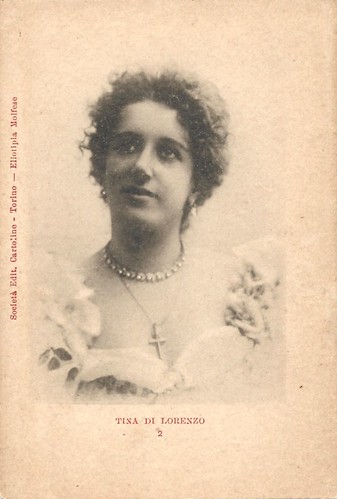
Italian postcard by Società Edit. Cartoline, Eliotipia Molfese, Torino, no. 2. Photo: Brogi.

Italian postcard by U.Z.M., no. 27. Tina Di Lorenzo in the play 'La Samaritana', written by Edmond Rostand.
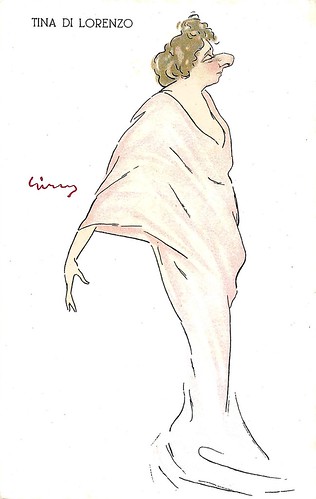
Italian postcard by CCM. Caricature by Girus (Giuseppe Russo, 1888-1960).
The anti-Duse
Tina Di Lorenzo was born in Turin in 1872 from the union between a Sicilian nobleman, Marquis Corrado Di Lorenzo di Castelluccio, and the actress Amelia Colonnello. Her father was a descendant of the Marquis of Castelluccio di Noto, a noble Sicilian family, while her mother was also from a noble family and lady-in-waiting to Queen Elena of Savoy.
At the age of 13, she trained in the dramatic arts in Naples and embarked on an acting career under the stage name Tina Di Lorenzo. Success came to her in 1889, at the Teatro Rossini in Naples, during a performance of 'Ruit hora' by Francesco Proto, Duke of Maddaloni, after which the press praised her great acting skills. Two years later, she was already the first actress in the Pasta company, with which she did a successful tour in Argentina.
On her return, she triumphed in Italy in such plays as 'Divorziamo' by Victorien Sardou, 'La trilogia di Dorina' by Rovetta, 'Le vergine' by Praga, 'Fedora' by Sardou, etc. She searched rather for bourgeois realism than for D'Annunzian exaltation. Indeed, Di Lorenzo was seen as the anti-Duse at that time. While some thought she was only really good in bourgeois comedy, she proved to be a good dramatic actress too in plays such as Bracco's 'Maternità' and Rostand's 'La Samaritana', showing she could be more than the wholesome, modest and joyful Italian woman.
In 1897, Tina Di Lorenzo joined Flavio Andò's company for a series of highly acclaimed performances throughout Italy. They also did an extensive tour through Eastern Europe, with plays such as 'Magda', 'Adrienne Lecouvreur' and 'La dame aux camélias'. She possessed a rare beauty, a melodious voice and the manners of a great lady despite her young age: she earned the nickname 'Angelicata' from her worshippers.
She was consecrated as a rising star of dramatic art and soon became one of the most sought-after actresses and sought-after by the chiefs. She toured extensively abroad, especially in Latin America. Thanks to her talent and beauty, she was nicknamed 'Encantadora' in Argentina. A friend of the "Red Count" Emanuele Bricherasio, in 1899 she became the first testimonial of the newly founded FIAT, posing on the Valentino avenues for an advertising photo, driving the "3 ½ HP" model.
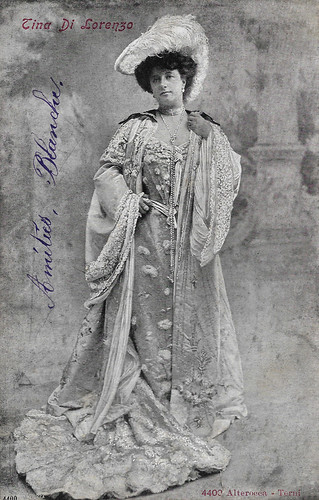
French-Italian postcard by Alterocca, Terni, no. 4400. Sent by mail in 1905.
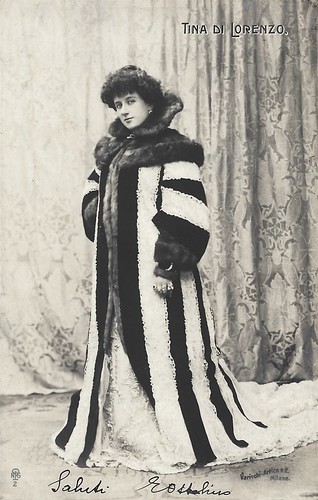
Italian postcard by NPG, no. 2.Photo: Varischi Artico & C., Milano.
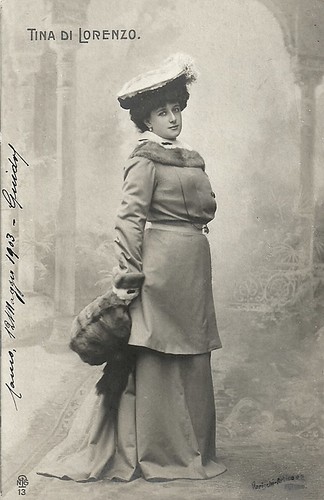
Italian postcard by NPG, no. 13. Photo: Varischi Artico & C., Milano. Sent by mail on 12 May 1903.
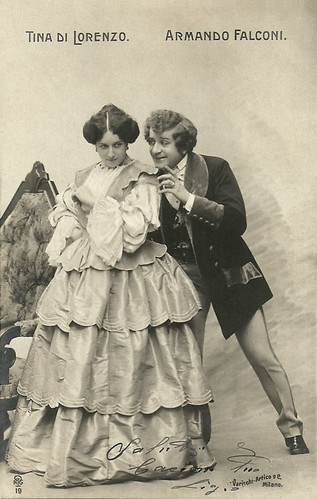
Italian postcard by NPG, no. 19. Photo: Varischi Artico & C., Milano. Armando Falconi and Tina Di Lorenzo.
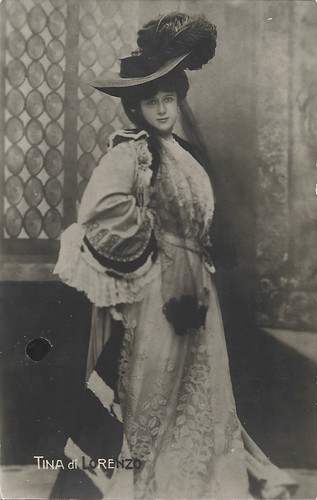
French postcard by P.P. & F. g. T.
A fortunately bloodless duel fought with pistols
In 1901 Tina Di Lorenzo married her cousin Armando Falconi, also an actor. Their love story began during a tour in Hungary, during which he defended her from the attacks of a journalist who painted Di Lorenzo in unflattering tones. Following a fortunately bloodless duel fought with pistols, Falconi prevailed and earned the love of his cousin, from whom their son Dino was born, a future writer-director.
Tina Di Lorenzo was part of numerous companies, from the Stabile del Teatro Manzoni in Milan (from 1912 to 1914) where she was prima donna, to the company of Francesco Pasta and Enrico Reinach to that of Flavio Andò, reaping an extraordinary and uninterrupted series of successes.
Tina Di Lorenzo participated in only three films. All three were made in 1915 at the Ambrosio company of Turin. Twice she acted together with her husband, Armando Falconi, in La scintilla (Eleuterio Rodolfi, 1915) and La bella mamma (Eleuterio Rodolfi, 1915). She acted opposite Annibale Ninchi in La gorgona (Mario Caserini, 1915). Only IMDb mentions the latter film, but she is not listed in Vittorio Martinelli's repertory 'Il cinema muto italiano ' as being part of the cast.
In her film debut La scintilla, based on a play by Alfredo Testoni, she is the naive wife of a man (Oreste Bilancia) who has a mistress, while the wife herself is courted by a young painter (Armando Falconi). When she finds out about her husband's affair she is so devastated that she almost makes a fatal misstep with the painter, but her young daughter saves the marriage and family. The press praised the performances by Di Lorenzo and Falconi but also realised this film was perhaps not made for the broad audience of cinema, lacking also the witty dialogues from the stage version. Di Lorenzo was by now a mature actress and not the young adult from the plot anymore. Yet, she remained convincing and touching, and all the pros were much more important than the cons. On the other hand, in her second film, La bella mama, in which she rivals as a mother with her daughter, played by Fernanda Negri Pouget, the press was less positive. It may have caused her to stop film acting, and focus on the stage.
Di Lorenzo retired to private life in the years between 1918 and 1920, returning to the stage only once, in 1926, at the Teatro Drammatico Nazionale in Rome, for an edition of Goldoni's 'La locandiera'. She died prematurely in Milan in 1930. That same year, a street in the city of Livorno was named after her. The Municipal Administration of Noto honoured its illustrious daughter Tina Di Lorenzo by naming the city's municipal theatre after her in 2011. Angelo Fortuna dedicated an intense biography to her: 'Tina Di Lorenzo. Il fascino e l'arte della encantadora'.

Italian postcard by TCR, no. 130. Photo: Bettini.
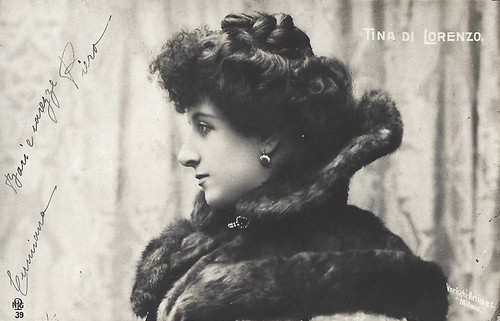
Italian postcard by NPG, no. 39. Photo: Varischi Artico & C., Milano.

Italian postcard, no. 23. Photo: Sciutto.

Italian postcard, no. 49. Photo: Sciutto.

Italian postcard by prob. Alterocca, Terni. Commemoration of the marriage of the actors Tina Di Lorenzo and Armando Falconi, in Livorno on 8 and 10 August 1901.
Sources: Roberta Ascarelli (Dizionario Biografico degli Italiani), Vittorio Martinelli (Il cinema muto italiano, 1915 - Vol. I and II), Wikipedia and IMDb.
No comments:
Post a Comment